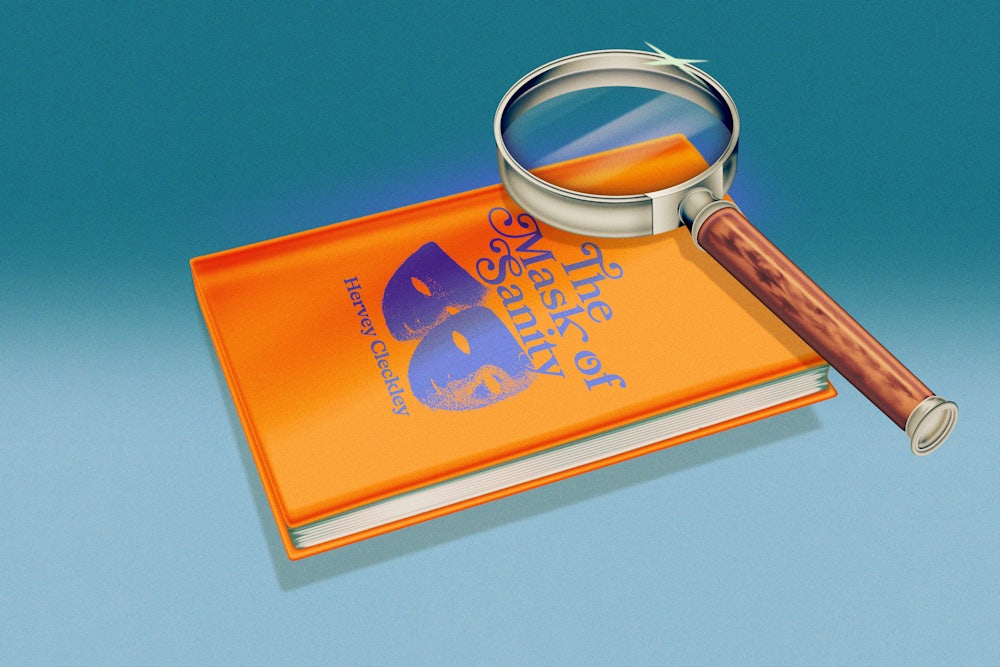In 1885, an English psychiatrist published the case of a man called W.B., who had spent much of his life cycling through jail and asylums. W.B. was “a quiet and useful man,” the doctor wrote in The Journal of Mental Science. He was educated, and enjoyed reading newspapers. He had also, since he was boy, enjoyed slicing up horses. Humans too. “He was fond of his stepmother but confessed that he planned to rape her,” the doctor reported. Unlike demented or melancholic patients, W.B. seemed to have every control over his reason. And yet he did unreasonable things. The doctor classified him as morally insane, a term that had evolved from the ideas of Philippe Pinel, the founder of modern psychiatry. As Pinel put it, there was the ordinary “evil that men do,” and then there was this kind. The incomprehensible kind.
People like W.B. were a puzzle for psychiatrists. Were they mad, or just plain bad? In 1941, Hervey Cleckley’s landmark book The Mask of Sanity finally gave them a name: psychopaths. The word was already in circulation as a loose catchall for intractable patients, but The Mask of Sanity defined the psychopath for the first time as a distinct type of person, one who could be identified according to 16 personality traits and behaviors. The psychopath was charming yet insincere, intelligent yet remorseless. He lied shamelessly and acted impulsively. (The majority of the patients Cleckley described were men.) Most troubling, he was perfectly indifferent to the pain of others, and experienced little emotion himself. For the psychopath, Cleckley wrote, “beauty and ugliness … goodness, evil, love, horror, and humor have no actual meaning.”
Later in his career, Cleckley would go on to publish one of the first detailed descriptions of multiple personality disorder. But it is his foundational work on psychopathy that has proved to have lasting influence. With The Mask of Sanity, Cleckley created one of the great mythic figures of the American imagination. The psychopath was a monster who walks among us, wearing the face of a human but devoid of an inner humanity. His invisibility made him as beguiling as he was dangerous. The psychopath had no tells; on first meeting he might seem as nice or as mean, or as unremarkable, as he chose. As the twentieth century rolled on to reveal atrocities of a scale and brutality previously unthinkable, psychopaths became a stand-in for serial killers, corporate fraudsters, and tyrannical political leaders. Their cunning acquired a dark tinge of genius.
Cleckley’s portrait of the psychopath was fundamentally sympathetic. He was “the forgotten man of psychiatry”: misunderstood, understudied, untreated. Cleckley’s successors, however, seized on the term as a way to understand society’s ills, often highlighting the most extreme and sensational personalities, and the public formed a picture of psychopaths as irredeemably diabolical. Psychopathy acquired a tantalizing aura that attracted prurience and voyeurism, moralizing and stigma. As the field came to understand more about them, Cleckley’s concern for psychopaths transformed into concern about psychopaths.
Cleckley wrote The Mask of Sanity while working as a psychiatrist at a Georgia state hospital, where he observed that about an eighth of his patients fit no existing diagnosis. These patients easily passed mental evaluations. They conversed normally, even pleasantly. By all appearances they were completely sane, and in fact they saw nothing unfit about themselves. But their records told the stories of people who were unable to lead normal lives. Cleckley likened psychopathy to a sort of emotional aphasia. The patient might convincingly mimic sound, but meaning was lost on him. As other researchers would put it later, he “hears the words but not the music.”
Despite the gravity of its topic, The Mask of Sanity is a lively and enjoyable work. This is mostly thanks to Cleckley’s detailed case studies. Cleckley writes with an attentive responsibility to his patients, some of whom he clearly finds endearing. His portraits highlight the individual idiosyncrasies of the psychopathic mind. A military veteran and boxer named Max, for example, is “bright as a dollar, smart as a whip.” Under confinement, Max declares himself to be an artist of unusual talent, sculpting chewed-up bread into religious iconography that he bestows graciously on hospital staff. In return he demands to be let out to buy paints, then a private room to use as a studio, and finally parole. All of these favors are granted; after his release, Max promptly gets into a bar fight and beats his wife. You get the sense that Cleckley finds Max’s scheme as ingenious as it is aesthetically repulsive.
Cleckley’s patients lie, steal, brawl, and sleep around. They cause chaos and disorder, though often without malice. (Says the mother of one patient, “I really think she means to stop doing all these terrible things, but she doesn’t mean it enough to matter.”) Many of them are not especially dangerous. It was the work of Robert Hare, a criminal psychologist, that would indelibly link psychopathy with violence.
Hare took Cleckley’s list of characteristics and created a quantifiable test. His Psychopathy Checklist, published in 1991, scores a person’s psychopathic traits on a scale from 1 to 40, with 30 marking the threshold for psychopathy. Applying this checklist to men in prison, Hare found that 20 percent of those he tested were psychopaths; for men who committed violent crimes, that rate went up to 50 percent. Hare also found that psychopaths were twice as likely as others to recommit a crime upon their release. His checklist is widely used to assess risk and determine, or deny, parole.
Hare’s work, while it significantly advanced the field by finding a neurological basis for psychopathy, treated psychopaths basically as a threat. If the Psychopathy Checklist could accurately weed out this ubiquitous and incurable presence, so much the better to protect the public. “Psychopaths are social predators who charm, manipulate, and ruthlessly plow their way through life, leaving a broad trail of broken hearts, shattered expectations, and empty wallets,” Hare wrote in his 1993 book, Without Conscience.
Interspersed throughout Without Conscience are genuinely shocking sound bites taken from news reports about killers and criminals. A representative sentiment: “Do I feel bad if I have to hurt someone? Yeah, sometimes. But mostly it’s like, how did you feel the last time you squashed a bug?” These accounts create the feeling that the book is discussing a dire problem of violent criminality, though Hare includes the disclaimer that he cannot be sure everyone in the book is, in fact, a psychopath. Several quotes from Ted Bundy make it in. Bundy had been executed just a few years before, a sensational event that only added fuel to the sensational media story created around him during his lifetime. Hare evaluated Bundy postmortem, awarding him a near-perfect psychopathy score of 39. The archetypal psychopath. The fact that this celebrity serial killer did not at all represent a typical psychopath was lost during his induction to American lore.
How many psychopaths are actually out there right now, buying you a drink or denying you a raise? According to Martha Stout’s bestselling 2005 book, The Sociopath Next Door, the answer is more than you want to know. One in 25 Americans is a sociopath, she claims, and that statistic is still cited today. But it cannot be true, because “sociopaths” don’t exist in psychiatry. (The term was briefly introduced in the twentieth century as an alternative to “psychopath,” but it only ever caught on in pop culture.) Nor is psychopathy an official diagnosis in the American Psychiatric Association’s Diagnostic and Statistical Manual of Mental Disorders, for that matter. Stout’s number comes from research on antisocial personality disorder, or ASPD, which replaced psychopathy after the DSM-III but is not at all the same thing. ASPD has far broader criteria, and ignores key personality traits like lack of empathy and shallow affect. Most estimates give the prevalence of true psychopathy in the United States to be a bit less than 1 percent. That’s about the same as anorexia and schizophrenia.
In The Sociopath Next Door, Stout characterizes “sociopaths” as a public health problem of biblical proportions, like a human plague. Stout is a Harvard psychologist, but her work, notably, does not concern psychopathy. She is a therapist for victims of psychological trauma. She published The Sociopath Next Door out of concern for her clients, many of whose lives had been shattered by sociopaths, she writes. How she knows this is left unexplained, as is her claim that sociopaths are the single most destructive force of humankind. She suggests, outrageously, that sociopaths must be behind just about everything bad that happens in human society, encompassing crime, financial crashes, and war. (She references 9/11 three times.) She writes: “The genuine horrors we see on television, and sometimes endure in our personal lives, do not reflect typical humankind. Instead, they are made possible by something quite alien to our nature—the cold and complete absence of conscience.” In this story, psychopaths are not only subhuman, they are something more akin to demons. And if this wasn’t enough to provoke a moral panic, Stout warns that sociopathy is on the rise due to the younger generation’s shift of values toward individualism. The Sociopath Next Door was so successful that Stout wrote a follow-up containing a sort of anti-sociopathy toolbox for the honest citizen. “Guideline #2: Understand that you are on the side of good.”
The sociopaths Stout is concerned about are people her readers might marry or work with. People like you. They’d fit the profile of what some psychologists call “successful psychopaths.” Successful psychopaths don’t end up in jail. Their psychopathic traits don’t cause egregious harm to others. They live a relatively normal life. In the real world this is a good thing—it means someone is managing their psychopathic traits well—but pop psychology books twisted functionality into a kind of superpower that gives sociopaths a competitive advantage in the workplace. This idea was bolstered by Hare’s 2010 study “Corporate Psychopathy,” which found that nearly 4 percent of a small test pool of managers had psychopathic traits, a rate three or four times higher than in the general population. The media ran with the findings, and you started to see self-help books titled The Wisdom of Psychopaths and The Psychopath’s Guide to Getting Ahead. The archetypal psychopath of the twenty-first century emerged as the white-collar criminal, resembling less Hannibal Lecter than Patrick Bateman, or Bernie Madoff.
As for the public, the idea of the careerist sociopath has become so pervasive that we’ve all taken to diagnosing as sociopathic anyone who’s managed to be both successful and unlikable, from Donald Trump to Mr. Beast. It is unclear what this sort of armchair diagnosis achieves, beyond confirming the obvious: that some people are jerks.
Nevertheless, if psychopathy is as common as the research suggests, that means there are a lot of people out there looking for answers. In 2008, a woman going by the pseudonym of M.E. Thomas started a popular blog about her life; it led to the bestselling book Confessions of a Sociopath. The recent memoir Sociopath, published earlier this year by Patric Gagne, is the latest book to offer a voyeuristic glimpse into a profoundly different mind. Gagne’s story starts in early childhood, when she develops the habit of stealing trinkets. Having no shame, she freely confesses each theft to her mother, earning her the affectionate, ironic nickname of “honest girl.” As she matures, so does her bad behavior. Soon she is serially breaking into her neighbors’ houses. In college she takes cars for joyrides. During her early career as a music agent, she stalks people. Oh, and she strangles a cat. (I suspect Gagne would have had a less fortunate life had she not grown up as a wealthy white woman with such a good mother.) As a protagonist, Gagne is somewhat irritating. She mostly comes off as arrogant and selfish, an all-around not-nice person. She fails to render any other person in her life with real dimension—unsurprising, probably, given her emotional impairment. But when Gagne, as an adult, wonders why the label of psychopath confers more stigma than information, and realizes she has no options for treatment, the book surfaces questions that are still unanswered in modern psychology.
In the past couple of decades, as psychiatry as a whole has moved toward a dimensional model, so has the medical understanding of psychopathy. Psychopathy is now thought of as a personality disorder that anyone might exhibit to a greater or lesser degree, similar to autism. Hare’s checklist offers a rudimentary spectrum, but its focus on criminality mutes the reality that the vast majority of psychopaths aren’t serial killers or perpetrators of financial fraud, they’re normal people who struggle to relate to others and to make decisions in their own interest. And just as no one wants to be called a psychopath, no one wants to help psychopaths, either. Compared to conditions that are just as common, research into psychopathy receives very little funding. “If you’re a psychopath you’re persecuted, not accommodated,” M.E. Thomas said in a recent talk with the advocacy organization Psychopathy Is.
Cleckley saw psychopathy not as a moral problem but as a health problem. “The psychopath has a genuine and often a very serious disability,” he wrote in the first edition of The Mask of Sanity. His fifth and final edition, published 35 years later, concluded that “few medical or social problems have ever so richly deserved and demanded a hearing.” Psychopaths had not yet gotten that hearing. They won’t, until we see what Cleckley saw: that psychopaths are not demons, not superheroes, not myths. They are just humans.






